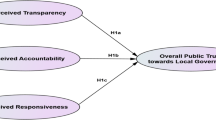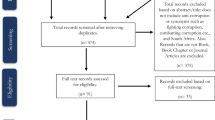Abstract
This study seeks to evaluate whether interorganizational trust and interpersonal trust influence the nature of state control in Brazilian public/non-profit partnerships (PNPs) by considering the social organization model with a non-profit partner that did not evolve organically from civil society as an equal and interdependent partner but instead was engineered by the state. We conducted qualitative research on two PNPs and analysed their historical trajectories through participant observation, documentary analysis and semi-structured interviews with the state and non-profit partners as well as other actors involved indirectly in the PNPs. Our findings call into question the assumption of current studies that trust tends to be built over time and reveal that PNPs embedded in state-dominant and low-social-capital contexts are more vulnerable to the effects of interpersonal trust. This vulnerability influences the volatile patterns of the PNPs’ trajectories and leads to strong informal state-partner control as reflected by PNP disruptions and lower levels of interorganizational trust.

Similar content being viewed by others
References
Alcoforado, F. C. G. (2010). Os e OSCIP: Uma análise da abrangência dos serviços públicos e do perfil das entidades parceiras em Minas Gerais, São Paulo e Espírito Santo. Revista do Mestrado em Administração,14(3), 47–65.
Alexander, J., & Nank, R. (2009). Public—nonprofit partnership: Realizing the new public service. Administration and Society,41(3), 364–386.
Aulakh, P. S., Kotabe, M., & Sahay, A. (1997). Trust and performance in cross-border marketing partnerships. In P. W. Beamish & J. P. Killing (Eds.), Cooperative strategies, North American perspectives (Vol. 1, pp. 163–196). San Francisco, CA: New Lexington Press.
Bachmann, R., & Zaheer, A. (Eds.). (2013). Handbook of advances in trust research. Edward Elgar Publishing.
Bardin, L. (1977). Análise de Conteúdo (70th ed.). Lisboa: Edições.
Bergamo, M. (2009). Maestro John Neschling é demitido da OSESP. Retrieved from http://www1.folha.uol.com.br/folha/ilustrada/ult90u492972.shtml.
Bidet, E. (2012). Overcoming labor market problems and providing social services: Government and civil society collaboration in South Korea. Nonprofit and Voluntary Sector Quarterly,41(6), 1215–1230.
Bloodgood, E., Tremblay, & Prakash, A. (2013). National styles of NGO regulation. Nonprofit and Voluntary Sector Quarterly,43(4), 716–736.
Bode, I., & Brandsen, T. (2014). State–third sector partnerships: A short overview of key issues in the debate. Public Management Review,16(8), 1055–1066.
Brandsen, T., Trommel, W., & Verschuere, B. (2015). The state and the reconstruction of civil society. International Review of Administrative Sciences. https://doi.org/10.1177/0020852315592467.
Bresser-Pereira, L. C. (1998). Uma reforma gerencial da Administração Pública no Brasil. Revista do Serviço Público, 49(1), 5-42. jan-mar. Retrieved from http://www.enap.gov.br/index.php?option=com_docman&task=doc_view&gid=2888. Accessed 10 de Agosto. 2014.
Brinkerhoff, J. M. (2002). Government-nonprofit partnership: A defining framework. Public Administration and Development,22(1), 19–30.
Brinkerhoff, J. M., & Brinkerhoff, D. W. (2002). Government-nonprofit relations in comparative perspective: Evolution, themes and new directions. Public Administration and Development,22(1), 3–18.
Brinkerhoff, D. W., & Brinkerhoff, J. M. (2011). Public-private partnerships: Perspectives on purposes, publicness, and good governance. Public Administration and Development,31(1), 2–14.
Brown, L. D., & Ashman, D. (1996). Participation, social capital, and intersectoral problem solving: African and Asian cases. World Development,24(9), 1467–1479.
Bryson, J. M., Crosby, B. C., & Stone, M. M. (2006). The design and implementation of cross-sector collaborations: Propositions from the literature. Public Administration Review,66(s1), 44–55.
Bunger, A. C. (2013). Administrative coordination in non-profit human service delivery networks: The role of competition and trust. Nonprofit and Voluntary Sector Quarterly,42(6), 1155–1175.
CharityWatch. (2014). CharityWatch hall of shame. Retrieved from https://www.charitywatch.org/charitywatch-articles/charitywatch-hall-of-shame/63.
Cornforth, C., Hayes, J. P., & Vangen, S. (2014). Nonprofit–public collaborations: Understanding governance dynamics. Nonprofit and Voluntary Sector Quarterly,41(6), 1215–1230.
Costin, C. (2005). Organizações sociais Como modelo para gestão de museus, orquestras e outras iniciativas culturais. Revista Eletrônica Sobre a Reforma do Estado,3(2), 15–28.
Dagnino, E. (2003). Citizenship in Latin America: An introduction. Latin American Perspectives,30(2), 211–225.
Das, T. K., & Teng, B. (1998). Between trust and control: Developing confidence in partner cooperation in alliances. Academy of Management Review,23(3), 491–512.
Dasgupta, P. (1988). Trust as a commodity. In D. Gambetta (Ed.), Trust: Making and breaking cooperative relations (pp. 49–72). New York, NY: Basil Blackwell.
Edwards, M., & Hulme, D. (1996). Too close for comfort? The impact of official aid on nongovernmental organizations. World Development,24(6), 961–973.
Eisenhardt, K. M. (1989). Building theories from case study research. Academy of Management Review,14(4), 532–550.
Ekiert, G., & Kubik, J. (2014). Myths and realities of civil society. Journal of Democracy,25(1), 46–58.
Emerson, K., Nabatchi, T., & Balogh, S. (2012). An integrative framework for collaborative governance. Journal of Public Administration Research and Theory,22(1), 1–29.
Ferrin, D. L., Bligh, M. C., & Kohles, J. C. (2008). It takes two to tango: An interdependence analysis of the spiraling of perceived trustworthiness and cooperation in interpersonal and intergroup relationships. Organizational Behavior and Human Decision Processes,107(2), 161–178.
Freitas, A. D. (1997). Traços brasileiros para uma análise organizacional. In F. C. Motta & M. P. Caldas (Eds.), Cultura organizacional e cultura Brasileira (pp. 38–54). São Paulo: Atlas.
Gazley, B. (2008). Beyond the contract: The scope and nature of informal government-nonprofit partnerships. Public Administration Review,68(1), 141–154.
Gazley, B. (2010). Linking collaborative capacity to performance measurement in government–nonprofit partnerships. Nonprofit and Voluntary Sector Quarterly,39(4), 653–673.
Goldbaum, S. (2003). Entrevista com Claudia Costin. RAE Executivo,2(3), 10–13.
Harlock, J. (2014). Diversity and ambiguity in the English third sector: Responding to contracts and competition in public service delivery. In T. Bransen, W. Trommel, & B. Vershuere (Eds.), Manufactoring civil society: Principles, practices and effects. London: Palgrave Macmillan.
Hodgson, L. (2004). Manufactured civil society: Counting the cost. Critical Social Policy,24(2), 139–164.
Horton, R. (2016). Offline: Uncivil society. Lancet,387(10023), 1041.
Huxham, C. (2003). Theorizing collaboration practice. Public Management Review,5(3), 401–423.
Ingold, K., & Leifeld, P. (2014). Structural and institutional determinants of influence reputation: A comparison of collaborative and adversarial policy networks in decision making and implementation. Journal of Public Administration Research and Theory,26(1), 1–18.
Inkpen, A. C., & Currall, S. C. (2004). The coevolution of trust, control, and learning in joint ventures. Organization Science,15(5), 586–599.
Kallman, M. E., & Clark, T. N. (2016). The third sector: Community organizations, NGOs, and nonprofits. Urbana, IL: University of Illinois Press.
Kapucu, N. (2006). Public-nonprofit partnerships for collective action in dynamic contexts of emergencies. Public Administration,84(1), 205–220.
Kenis, P., & Provan, K. G. (2009). Towards an exogenous theory of public network performance. Public Administration,87(3), 440–456.
Klijn, E.-H., & Teisman, G. (2000). Governing public–private partnerships: Analysing and managing the processes and institutional characteristics of public–private partnerships. In K. McLaughlin & S. Osborn (Eds.), public–private partnerships (pp. 84–102). London, UK: Routledge.
Lee, H., Robertson, P. J., Lewis, L., Sloane, D., Galloway-Gilliam, L., & Nomachi, J. (2012). Trust in a cross-sectoral interorganizational network: An empirical investigation of antecedents. Nonprofit and Voluntary Sector Quarterly,41(4), 609–631.
McLoughlin, C. (2011). Factors affecting state-non-governmental organization relations in service provision: Key themes from the literature. Public Administration and Development,31(4), 240–251.
Mendonça, P., & Falcão, D. (2016). Novo Marco Regulatório para a realização de parcerias entre Estado e Organização da Sociedade Civil (OSC). Inovação ou peso do passado? Cadernos Gestão Pública e Cidadania,21, 44–62.
Milbourne, L., & Cushman, M. (2013). From the third sector to the big society: How changing UK government policies have eroded third sector trust. VOLUNTAS: International Journal of Voluntary and Nonprofit Organizations,24, 485. https://doi.org/10.1007/s11266-012-9302-0.
Nogueira, M. (2004). Um Estado para a Sociedade civil: Temas Éticos e Políticos da Gestão Democrática. São Paulo: Cortez.
Noy, C. (2008). Sampling knowledge: The hermeneutics of snowball sampling in qualitative research. International Journal of Social Research Methodology,11(4), 327–344.
Pannunzio, E. (2014). Dá para confiar na Sociedade Civil? Brasil Post, 22 de Abril de 2014. Retrieved from http://www.brasilpost.com.br/eduardo-pannunzio/da-para-confiar-na-sociedade-civil_b_5153273.html.
Peci, A., Figale, J., & Sobral, F. (2011). The “invasion” of manufactured civil society: Government-nonprofit partnerships in a Brazilian state. Public Administration and Development,31(5), 377–389.
Rhode, D. L., & Packel, A. K. (2009). Ethics and nonprofits. Stanford social innovation review. Retrieved from www.ssireview.org/articles/entry/ethics_and_nonprofits.
Ring, P. S., & Van de Ven, A. H. (1994). Developmental processes of cooperative interorganizational relationships. Academy of Management Review,19(1), 90–118.
Romzek, B. S., LeRoux, K., & Blackmar, J. M. (2012). A preliminary theory of informal accountability among network organizational actors. Public Administration Review,72(3), 442–453.
Romzek, B. S., LeRoux, K., Johnston, J., Kempf, R. J., & Piatak, J. S. (2014). Informal accountability in multisector service delivery collaborations. Journal of Public Administration Research and Theory,24(4), 813–842.
Saab, D. J., Tapia, A., Maitland, C., Maldonado, E., & Tchouakeu, L. M. N. (2013). Inter-organizational coordination in the wild: trust building and collaboration among field-level ICT Workers in humanitarian relief organizations. VOLUNTAS: International Journal of Voluntary and Nonprofit Organizations,24, 194–213. https://doi.org/10.1007/s11266-012-9285-x.
Salamon, L. M., Sokolowski, S. W., & Haddock, M. A. (2017). Explaining civil society development: A social origins approach. Baltimore, MD: Johns Hopkins University Press.
Sano, H., & Abrucio, F. L. (2008). Promessas e resultados da Nova Gestão Pública no Brasil: o caso das organizações sociais de saúde em São Paulo. RAE—Revista de Administração de Empresas,48(3), 64–80.
Secretaria da Cultura. (2017). Boletim Cultura em Números. São Paulo: Secretaria da Cultura. Retrived from http://www.transparenciacultura.sp.gov.br/wp-content/uploads/2016/03/2017.01.04-Boletim-UM-n.-1-Cultura-em-N%C3%BAmeros-atualizado-1.pdf.
Selsky, J., & Parker, B. (2005). Cross-sector partnerships to address social issues: Challenges to theory and practice. Journal of Management,31(6), 849–873.
Skelcher, C., Mathur, N., & Smith, M. (2005). The public governance of collaborative spaces: Discourse, design and democracy. Public Administration,83(3), 573–596.
Sobral, F., Carvalhal, E., & Almeida, F. (2007). O estilo brasileiro de negociar. Revista Portuguesa e Brasileira de Gestão,6(2), 32–42.
Stace, H., & Cumming, J. (2006). Contracting between government and the voluntary sector: Where to from here. Policy Quarterly, 2(4), 13–20.
Sullivan, H., & Skelcher, C. (2003). Working across boundaries: Collaboration in public services. London: Palgrave.
Teodósio, A. S. (2002). O terceiro setor e a provisão de políticas sociais: Desafios, perspectiva e armadilhas da relação entre organizações da sociedade civil e estado em Minas Gerais. Anais do X Seminário sobre Economia Mineira,2002, 18–22.
Van Slyke, D. M. (2007). Agents or stewards: Using theory to understand the government-nonprofit social service contracting relationship. Journal of Public Administration Research and Theory,17(2), 157–187.
Vlaar, P. W. L., Van den Bosch, F. A. J., & Volberda, H. W. (2007). On the evolution of trust, distrust, and formal coordination and control in interorganizational relationships: Toward an integrative framework. Group and Organization Management,32, 407–428.
Yin, R. (2005). Estudo de Caso: Planejamento e Métodos (3rd ed.). Porto Alegre: Bookman.
Zaheer, A., McEvily, B., & Perrone, V. (1998). Does trust matter? Exploring the effects of interorganizational and interpersonal trust on performance. Organization Science,9(2), 141–158.
Zaheer, A., & Venkatraman, N. (1995). Relational governance as an interorganizational strategy: An empirical test of the role of trust in economic exchange. Strategic Management Journal,16(5), 373–392.
Acknowledgements
The authors would like to thank the support of Evelyn Contreras Medrano during field research. We would like to thank the funding support of CNPq (Conselho Nacional de Pesquisa e Desenvolvimento Tecnologico), Grant Number 310976/2014-6, and Faperj (Fundação de Amparo à Pesquisa do Estado do Rio de Janeiro), Grant Number E_17/2012.
Author information
Authors and Affiliations
Corresponding author
Ethics declarations
Conflict of interest
The authors declare that they have no conflict of interest.
Rights and permissions
About this article
Cite this article
Peci, A., Oquendo, M.I. & Mendonça, P. Collaboration, (Dis)trust and Control in Brazilian Manufactured Public/Non-profit Partnerships. Voluntas 31, 375–389 (2020). https://doi.org/10.1007/s11266-018-0027-6
Published:
Issue Date:
DOI: https://doi.org/10.1007/s11266-018-0027-6




